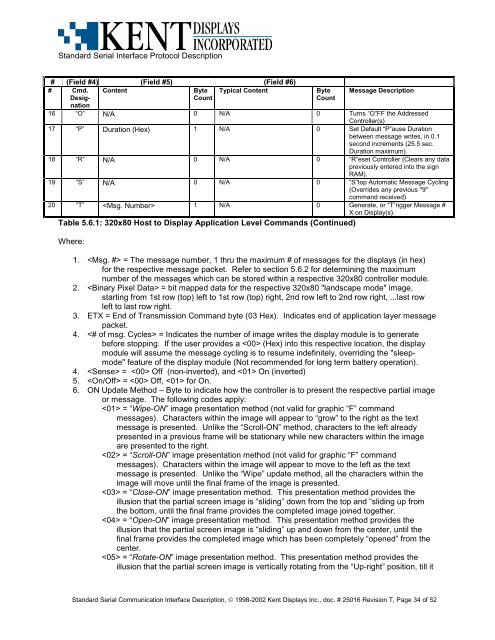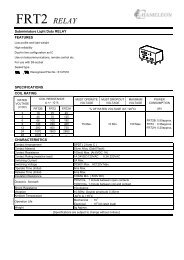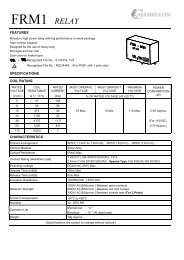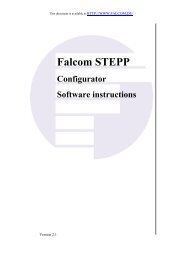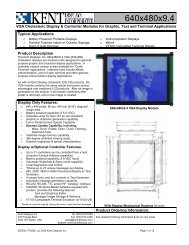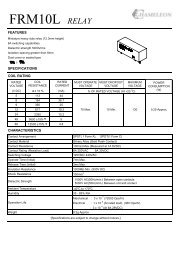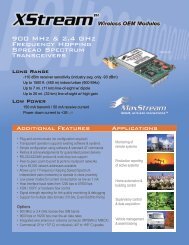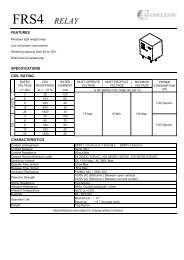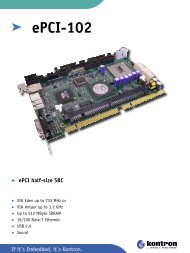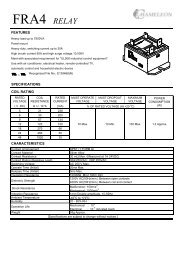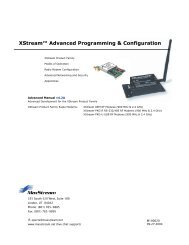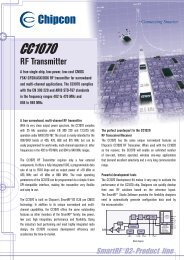STANDARD SERIAL COMMUNICATION INTERFACE and ...
STANDARD SERIAL COMMUNICATION INTERFACE and ...
STANDARD SERIAL COMMUNICATION INTERFACE and ...
You also want an ePaper? Increase the reach of your titles
YUMPU automatically turns print PDFs into web optimized ePapers that Google loves.
St<strong>and</strong>ard Serial Interface Protocol Description<br />
# (Field #4) (Field #5) (Field #6)<br />
# Cmd.<br />
Designation<br />
Content<br />
Byte<br />
Count<br />
Typical Content<br />
Byte<br />
Count<br />
Message Description<br />
16 “O” N/A 0 N/A 0 Turns “O”FF the Addressed<br />
Controller(s)<br />
17 “P” Duration (Hex) 1 N/A 0 Set Default “P”ause Duration<br />
between message writes, in 0.1<br />
second increments (25.5 sec.<br />
Duration maximum).<br />
18 “R” N/A 0 N/A 0 “R”eset Controller (Clears any data<br />
previously entered into the sign<br />
RAM).<br />
19 “S” N/A 0 N/A 0 “S”top Automatic Message Cycling<br />
(Overrides any previous "9"<br />
comm<strong>and</strong> received)<br />
20 “T” 1 N/A 0 Generate, or “T”rigger Message #<br />
X on Display(s).<br />
Table 5.6.1: 320x80 Host to Display Application Level Comm<strong>and</strong>s (Continued)<br />
Where:<br />
1. = The message number, 1 thru the maximum # of messages for the displays (in hex)<br />
for the respective message packet. Refer to section 5.6.2 for determining the maximum<br />
number of the messages which can be stored within a respective 320x80 controller module.<br />
2. = bit mapped data for the respective 320x80 "l<strong>and</strong>scape mode" image,<br />
starting from 1st row (top) left to 1st row (top) right, 2nd row left to 2nd row right, ...last row<br />
left to last row right.<br />
3. ETX = End of Transmission Comm<strong>and</strong> byte (03 Hex). Indicates end of application layer message<br />
packet.<br />
4. = Indicates the number of image writes the display module is to generate<br />
before stopping. If the user provides a (Hex) into this respective location, the display<br />
module will assume the message cycling is to resume indefinitely, overriding the "sleepmode"<br />
feature of the display module (Not recommended for long term battery operation).<br />
4. = Off (non-inverted), <strong>and</strong> On (inverted)<br />
5. = Off, for On.<br />
6. ON Update Method – Byte to indicate how the controller is to present the respective partial image<br />
or message. The following codes apply:<br />
= “Wipe-ON” image presentation method (not valid for graphic “F” comm<strong>and</strong><br />
messages). Characters within the image will appear to “grow” to the right as the text<br />
message is presented. Unlike the “Scroll-ON” method, characters to the left already<br />
presented in a previous frame will be stationary while new characters within the image<br />
are presented to the right.<br />
= “Scroll-ON” image presentation method (not valid for graphic “F” comm<strong>and</strong><br />
messages). Characters within the image will appear to move to the left as the text<br />
message is presented. Unlike the “Wipe” update method, all the characters within the<br />
image will move until the final frame of the image is presented.<br />
= “Close-ON” image presentation method. This presentation method provides the<br />
illusion that the partial screen image is “sliding” down from the top <strong>and</strong> “sliding up from<br />
the bottom, until the final frame provides the completed image joined together.<br />
= “Open-ON” image presentation method. This presentation method provides the<br />
illusion that the partial screen image is “sliding” up <strong>and</strong> down from the center, until the<br />
final frame provides the completed image which has been completely “opened” from the<br />
center.<br />
= “Rotate-ON” image presentation method. This presentation method provides the<br />
illusion that the partial screen image is vertically rotating from the “Up-right” position, till it<br />
St<strong>and</strong>ard Serial Communication Interface Description, © 1998-2002 Kent Displays Inc., doc. # 25016 Revision T, Page 34 of 52


